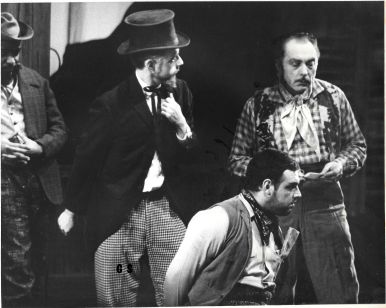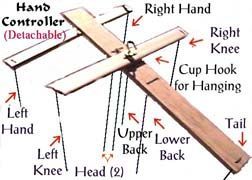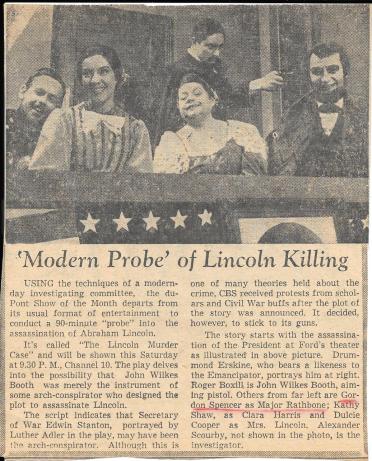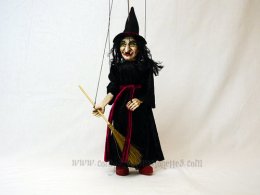I decided that, in order to be a professional actor, I had to behave like one and market myself, which true professionals already knew and practiced. Given Vene’s income and a residue of mine, plus qualifying…again…for unemployment insurance, I could afford a few career necessities.
Joining the Screen Actors Guild was one, meaning I could, presumably, get more, better-paid film work. It also meant shelling out for an initiation fee plus regular dues. (FYI: In 2011 the initiation fee was $2,277; a 1960 equivalent was about $300.) SAG has always had eligibility requirements; it’s never been possible to join on a whim. But my membership in AFTRA made me eligible. Joining Actor’s Equity was far more complicated than that.
I also paid for a listing in The Talent Guide, a book available to all union performers in which we were allowed one photo and a short résumé. Casting agents were known to go through the pages, or look us up if our names came to their attention.
Plus, I hired an answering service, Hayes Registry, recommended by other actors I’d met. Given that neither Vene nor I were at home during the day to answer the phone, there was no other way to know which leading director or major casting person was urgently trying to reach me for a big role or a significant audition.
Hayes operators were always sweet and friendly when I called in. “Hello, dear,” was a regular greeting. The offices occupied a floor on West 46th Street, just off Times Square, and we were always invited to stop by to use the bathroom or have some coffee. On the street level, Hayes had a small framed picture above eye level with a glossy of “The Performer of The Week,” naming the venue of appearance. When I landed a role in a DuPont Show of the Month (more below), I asked them to post mine, which they did. Another time, passing by, I noticed a photo of a goofy-looking guy named Rip Taylor, flourishing a handkerchief, billed as “The Famed Cry Comic.” He became better known later.
Buying sheet music of some songs I knew and liked, I took them with me to a couple of professional vocal coaches to help me learn how to sing them in case I got a chance to be in a musical. I had a good ear. No surprise, coming from a family of musicians and immersed in all kinds of music on my own radio programs. I couldn’t actually read the notes but could tell, looking at scores, where they went up and down, and how to hold the notes long or short.
Meanwhile, out there all over the microcosmic fragments of Manhattan where theatre thrived, Broadway, off-Broadway, I was making the rounds, going to as many open casting calls as possible. An open call, FYI, is something publicly announced by producers, usually giving cast requirements, telling what roles are open, inviting anyone interested to show up for auditions at a published time and place, the listings posted in Show Business Weekly or Variety.
In late November 1960, at such an open call, I got my first role. Brooklyn Theatre Arts was producing Lerner and Loewe’s musical Paint Your Wagon. My beard, a rarity, must have suggested the kind of character you’d see in the Old West mining camps that the show portrayed. The singing audition, my first, followed the standard pattern. A pianist was provided to accompany my choice of song, i.e., what my coaches had prepped me for. So I sounded as if I knew what I was doing.
My seemingly authentic English accent could have helped; I landed the supporting role of Englishman Edgar Crocker who figures in a few subplot developments, with a little dialogue but no songs of his own, vocalizing in the choruses.
A plus: I could walk to rehearsals, a few blocks away from my home. Brooklyn Theatre Arts was undertaking this new project in the magnificent, historic landmark, The Brooklyn Academy of Music, evidently trying to develop an audience there for theatre.

Members of Actors Equity were in the cast, although I hadn’t yet qualified to become a member. The union contracts allowed for some non-Equity people. The production ran for two weekends.
Where was I going? I don’t know. What would I do there? I’m not certain. All I knew was I was on my way. (A paraphrase from Alan Jay Lerner’s lyrics from the show.)
Around the same time, Suzari Marionettes posted a notice in Backstage, a new and second weekly newspaper like Show Business, that the company was casting Jack and the Beanstalk, a children’s show, over the Christmas holidays and was looking for someone to play The Giant.
Ah-hah! My beard again would make me look right.
My résumé got me in the human-sized door and I was invited to the Suzari workshop and studios on Irving Place.
Inside a small office, within what looked like a large, converted garage, I was introduced to two short older women who ran the company, Dorothy Zaconick and Ruth Waxman. They looked more like somebody’s aunts than show business producers.
They asked about my experience in children’s shows so I referred to Meet Mr. Easter Bunny, which was on my résumé. Then they wanted to know if I could perform in voices other then my own, indifferent to my radio-style resonance. I grabbed a newspaper from a nearby desk and read a New York Times story about airlines going to Bermuda and Frankfurt, sounding like an older cockney woman and a gruff, dynamic German.
They gave me the script.
Not wanting to be a standard story-book Giant nor frighten kids too much, spontaneously I played him as a goof. “Fee, Fi, Fo…duh,” I said, even though that was not the way his line was written. “Duh…Fee, Fi, Fo…Phooey.” Dorothy and Ruth howled with laughter, so much so that cigarette-smoking Ruth couldn’t stop hacking and coughing.
The Giant, they explained, would appear on stage live, towering over the 18- inch high marionettes. But, since he wouldn’t always be on stage, I’d also have to voice a few other roles while maneuvering a few marionettes. Could I do that, they asked?
Sure.
The role was mine.
I’d never touched a marionette in my life but they didn’t seem worried, convinced that I could learn and would get enough training during rehearsals.
The pay was even better than for Paint Your Wagon.
The show was to run 10 days in Lazarus Department Store in Harlem, two performances a day on weekdays and three on one weekend. We’d get a lunch break every day…Ooo! Ribs!
But I had to supply my own tights. That figures. Who’d want to wear used underwear, even if it had been thoroughly laundered? I was also expected to provide my own makeup, but that was standard. Thus, I had another expense, buying and supplying my own makeup kit, something I hadn’t done yet. However, Suzari would give me the rest of the costume.
I quickly learned the simple script. There was nothing fresh in it. Except my new take on The Giant. During rehearsals Nick Coppola, the director, would voice and manipulate Jack. And a seemingly frail older woman, Mary Morris, would do the same for Jack’s mother and The Giant’s wife. They also loved my interpretation. I was even allowed to ad-lib some of his dialogue, so long as it didn’t take up too much of the hour that the show was supposed to run.
Less easy was learning how to manipulate a marionette. I had to operate the little guy with the beans, while also voicing his dialogue into a microphone suspended over the puppet stage, facing the mike directly, trying to look down at the puppet’s movements.
This while bending over the stage from a platform six feet above it. That height was necessary to make sure that no puppeteer’s hands would show manipulating the controls and high enough that puppets’ feet would sit naturally on the stage. Fortunately, my back was in good shape and, since I went up and down the ladder to go on stage as The Giant, I didn’t have to stay bent for the whole hour.

The control was shaped like a cross, with an upper bar clipped to the rest of the body. All of the control connected to the puppet with fish line attached to various parts of the body. The clip bar controlled the legs by lines attached just above the knees. Tilting it up and down moved the legs. The bottom end of the cross had a line attached to the puppet’s back. Pulling that up made the puppet bend at the waist. At the front were two lines connected to the sides of the puppet’s head; moving back and forth suggested talking. And underneath the front of the cross was a single line connected to both hands; it ran through two eye-hole screws. Pulling the line right raised the puppet’s left hand and vice versa.
The show was a hit, with kids yelling from the audience at The Giant, making fun of his mistakes, happy that they were smarter than he was. I loved it.
At the end of the run, Ruth and Dorothy asked me if I’d like to perform with them again, after the New Year started. They were planning a TV series of Suzari shows with Jack and the Beanstalk as the pilot, with me, of course, as The Giant. Naturally I was delighted.
Late in January, they called to say that they were going to shoot it in March, asking if I was free. I was.
Then, early in February 1961, I got a call from Audrey Gellen of Talent Associates.
Talent Associates! That was a major TV producing company, headed by David Susskind.
That sounded as if I was on my way to stardom.
Audrey asked me to come into the office; she thought she had a role for me. And that, without even an audition.
She had seen my picture in The Talent Guide and thought I looked like Major Henry Rathbone, one of the two other people with the Lincolns in the box at Ford’s Theater the night of the assassination. Taking a look at me, she said, “Yep, you’re just right.”
They were producing a DuPont Show of the Month: The Lincoln Murder Case. A one-week rehearsal would start in two weeks, for broadcast on February 18th, 1961. And right away I had to go for an early costume fitting because I/Rathbone would be in advance publicity photos. Oddly, she didn’t give me a script.
The pay: $400, equal to about $2,940 in 2011. A windfall.
At the costume shop I could tell immediately who Drummond Erskine was going to play. He was thin as a rail, tall and angular with a bony face. “Wow!” I exclaimed to him. “You’re gonna play Lincoln! Congratulations!”
“Oh,” he replied, “it’s not a starring role. It’s one of those ‘five lines or under parts.’” That was a term of art meaning any SAG or AFTRA performer in that category worked for a minimum scale different from that for any larger role.
“So you read the script?” I asked.
“Sure. I have a few lines. Actually, the script is mostly about Booth and the conspirators.”
“I’m playing Rathbone,” I said.
“Uh-huh. He doesn’t say anything at all. He’s just in a couple of shots.”
So much for my big break.
The photo session was for five of us: Drummond, Dulcie Cooper as Mrs. Lincoln, Kathy Shaw as Clara Harris, and Roger Boxhill as Booth, the only big role. The publicity picture showed Booth pointing a pistol at Lincoln’s head with the rest of us laughing as if enjoying the play.
It appeared in a lot of newspapers. When my father saw it, he telephoned, delighted, but asked me why I hadn’t told him yet about this big role. I explained the facts to him.

When I walked in on the first day of rehearsals, Director Alex Segal looked at me and said “Who are you?”
“I’m Gordon Spencer.”
Impatiently he responded. “No. I meant which character are you supposed to play?”
“Rathbone,” I answered, surprised that he didn’t recognize my resemblance.
“Rathbone didn’t have a beard.”
“Oh. But Audrey Gellen at Talent Associates said I look just like him.”
“I don’t care what she said. You want the part? Take off the beard.”
That shook me up. My very specific face felt like part of my identity. And how would I play The Giant in a few weeks looking so average and younger than 28?
Who would turn down $400 for a week of work? And, after all, the hair would grow back again.
The show was narrated by Alexander Scourby, a man whose voice and style set a standard many of us narrators and announcers aspired to. Luther Adler had the pivotal role of Secretary of War Edwin Stanton, who, according to Dale Wasserman’s adaptation of the book, The Web of Conspiracy by Cliff Englewood, implied that Stanton was the mastermind behind the plot to assassinate Lincoln. Andrew Prine and House Jameson were also in the cast.
Most of the rehearsal time I just hung around talking to some of the actors and reading books, since all I would have to do was to pose for a few front face camera shots when the narration referred to Rathbone. The actions: Smile as if enjoying the play. And, at one point, Rathbone would take Clara’s hand and press it. Neither she nor Rathbone nor Mrs. Lincoln would be seen reacting to the murder, nor would there be any depiction of Rathbone grabbing Booth and getting stabbed, as actually happened.
Everyone in the production knew that this would be broadcast live. That was not unusual. But we were all hoping to see the tape later. Then we were told that that DuPont Show of the Month would not be taped.
The previous month’s production, the elaborate costume drama, The Prisoner of Zenda, starring Christopher Plummer and Farley Granger, had run way over budget and costs for February’s had to be severely curtailed.
The broadcast was at 9 p.m. that Saturday night and we had to arrive at the studio at 5 to get into our costumes and makeup. This was the big time. No one in the cast did his/her own makeup. Famed Dick Smith and his staff did that, putting wigs, beards, mustaches on most of the men.
Earlier in the day I had shaved my entire face in preparation, shocked at what I saw in the mirror and hadn’t seen for more than three years. And the bare skin of my chin, jaw, and upper lip seemed so naked. And chilly.
So while so many other men were getting facial hair, I had lost mine. Plus, for the next five hours, I had mutton chop sideburns and a fake mustache.
I had been able to look at all of the scenes and hear all of the dialogue during rehearsals. But for the actual performance, I just had to sit in the set and wait for a little red lights to go on in cameras in front of me, when Alexander Scourby said a few words about Rathbone and Clara. I wasn’t nervous. It was so quiet on the set, and there was no live audience sitting out in front. It was like being on the radio. Except that I didn’t speak.
So, how was the show, Mrs. Lincoln? I have no idea. Vene told me that I looked fine. That Sunday my in-laws and my father also telephoned, congratulating me for such a good performance, convinced that I was on my way to a major acting career.
The next week rehearsals started for the new version of Suzari’s Jack and the Beanstalk.
Walking into the shop, worried about how I looked and that perhaps the beard had been crucial to being Giant-like, I wondered if the role was still mine, what with my short, rounded chin and that bland face.
Nick greeted me. “Hey, Gordon, you look different somehow. Did you just get a haircut or something?”
I was astonished to see that what was so significant to me was not more noticeable. “I had a lot of hair cut,” I replied. “I had to take off the beard for a TV role.”
“We’ll work something out,” Ruth said. “Do you know how to make one?”
I did. And, since we still had two weeks of rehearsals, I thought maybe a real one would grow back by then. Or, perhaps, the Giant could look even more menacing if he had the kind of stubble that made him look like a slob.
Dorothy took the role of Jack; Nick, Mary, and Hal Oakley would voice and manipulate the other puppets. All I had to do was concentrate on The Giant. Great!
Dorothy was the principal designer of all the marionettes and decided to devise a new, more detailed version of Jack, adding extra strings to get more subtle movements.
And Frank Devlin was hired to direct; he had TV children’s show experience.
Camera rehearsals were scheduled for the same night as the shoot at the studios of WCAU-TV in Philadelphia, former haunt of Shock Theatre’s “Roland” and where Ruth had managed to get bargain rates for the rental. We would have the studio from 10 p.m. until 5 a.m. to rehearse in the new space and turn out a one-hour show.
Those seven hours were full of problems. Dorothy kept getting extra strings tangled and tied up and was getting anxious and irritated. Soon, Ruth was getting irritated with Dorothy. The rest of us plugged gamely along, rehearsing and taking snack breaks using WCAU’s vending machines down the hall.
At various times, when our characters were not on camera, we looked at the monitors to see how everything looked and what Frank was doing with the two camera men. Most often it seemed that he didn’t know how to make the magic of puppets work on camera. He constantly shot close-ups. Which, of course, made it clear that the marionettes were not moving their mouths or their eyes. We did a hell of a lot of re-takes as he tried to come up with something better. But he didn’t come up with something better.
The final take looked boring. And, exhausted, all of us checked into a nearby hotel in the early morning knowing we did not have a hit on our hands.
Not long thereafter, Ruth and Dorothy split up their partnership. Dorothy had first choice of puppets, validly; she had designed many of them. She also kept the Suzari name. Ruth got a few good puppets and retained the studio and workshop, as well as the right to use any of the performers she wanted. She named her company Nicolo Marionettes, evidently to honor Nick, who’d been with her from his teens. An interesting post from another actor/puppeteer.
Over the next five years I would perform intermittently for Nicolo Marionettes. Usually when other acting work didn’t seem to be coming along. Which was often.
I became quite a skilled puppeteer. And experience as an ad-libber on the radio stood me in good stead for all the times when we had to improvise due to minor problems backstage. Strings got tangled, delaying the appearance of some characters; other puppets would have to hold the stage and fill in with dialogue. Or a puppet would fall off the rail; someone would have to leave the bridge and pick it up off the floor and make sure the strings were not tangled while the remaining cast members had their characters say something to fit the story’s development that far. Or someone would forget some lines or say something in the wrong voice. Or we’d be asked to shorten the show because of a change in the clients’ schedules.
Stan Sobel and Zita Schwab sometimes worked with me. Together we once even traveled away from New York for an afternoon performance in a school in Arlington, VA, to be followed by a morning show in Morgantown, WV. That’s a distance of more than 200 miles to be traveled in our van over turnpike-less, not-yet-Interstate highways, along night-time mountain roads.
We notably passed through Webster, WV, cited, sign-wise, as the home of Anna Marie Jarvis, the woman behind Mother’s Day. We arrived nervous and exhausted with no time for much sleep. And we set up in a small movie house with a backstage ceiling so low that we couldn’t stand upright on the bridge.
Sometimes improvisation went too far; we started having more fun adding verbal or visual gags for our own amusement. Sticking to the script many times in a row could have seemed boring to those of us who lacked discipline. We’d forget that the audience had never seen the show before and might have trouble following it as it derailed into something barely resembling the original.
For any professional stage show, during the run, with the director usually gone elsewhere, there’s always a stage manager backstage making sure that the original concept stays intact. But the stage manager has no say in what actors do when they think that they’re improving roles as the run keeps on going. The actors may think they’re making everything fresher. But the internal sense of the show can fall apart. Nicolo had no stage managers.
Our directors never traveled with the three-person casts, so we were on our own. But, by the time I had become an on-the-road manager, I had gone with Nick to see a performance by the returning national company at a booking in Brooklyn of The Tinderbox. Hardly any of the script was left. The cast was doing its own thing. No one was fired. But everyone was warned. That’s how we learned how we could ruin our own shows.
Most scripts did not call for human-sized actors, although I was one in The Emperor’s Nightingale and in Hiawatha. And women in our casts of Alice in Wonderland took the stage as the big, transformed version of Alice.
Sometimes, on the road, we had three shows with us, a repertory cast of marionettes, several doubling in more than one show. There was often a witch. Nick loved playing her. He tended to be edgy, so, constrained from being too nasty with those of us sharing the bridge with him, skinny Nick would channel his feelings into those skinny creatures in black. After all, in many ways it was his company. He took that seriously and had a hard time with anyone’s mistakes, including his own.

Our total repertory: the above, plus Rumpelstiltskin, Sleeping Beauty, The Wizard of Oz (each with a witch), and, of course, Jack and the Beanstalk.
Each engagement required three hours—one to set up everything, one to perform the show, one to tear down. The entire show traveled in a van, with the three of us sitting up front. We had to unload the van, set up the stage, the lights, the sound system including speakers, and the bridge behind and above the stage. That’s a lot for three people to do quickly. So Ruth’s contracts with clients required 10 volunteers, usually boys, to assist before and after the show. But only we would unpack the marionettes suspending them on the bridge’s wooden rails with S-hooks, bent wire hangers. It was strenuous. But we were young. And we had a great time.